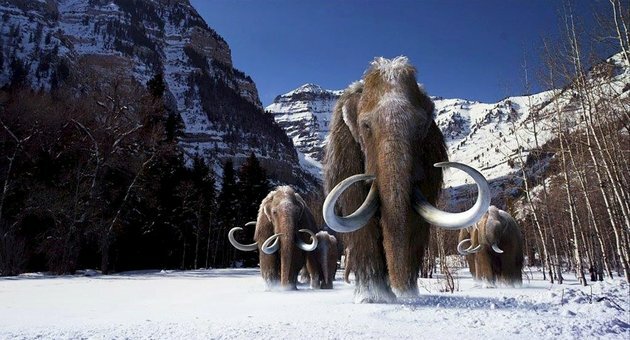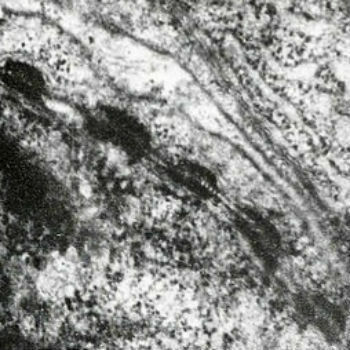The mammoth (Mammuthus) is a mammal in the same family as elephants and was extinct over 10,000 years ago. They were considered sociable animals, as they lived in groups.
Its ivory tusks, trunk and exuberant size are its hallmarks.
Mammoth Characteristics

The mammoth's size is one of its main characteristics, some species could reach up to 5 meters in height and weigh up to 20 tons.
They had a thick layer of fur and fat to help withstand the low temperatures of the places they lived.
Ivory tusks were used to dig snow and mark territory. Also, males with larger, more curved tusks could mate with females. The size of prey in males had an average of 2.5 meters and in females, the average size was 1.6 meters.
Their trunks reached approximately 3 meters in length and helped to remove snow and feed, which was based on roots, leaves, vegetables and fruits.
Mammoth Habitat

Found mainly in places with low temperature, researchers report that mammoths lived in the European, Asian, African and also North America continents, around 10,000 to 20,000 years back.
Siberia was where mammoths survived until they became extinct. It is also in this region that fossils with better conservation status were found. This is because the cold place in which they lived, covered with ice, contributed to the preservation of their characteristics, preventing their decomposition.
Mammoth extinction
Extinct at the end of the Ice Age, mammoths are studied from fossils found by researchers and archaeologists.
There are two theories about the extinction of mammoths, but it is not clear what the main reason is.
The first of them is related to climate changes, as they contribute to the increase in temperatures, the melting of glaciers and the increase in humidity and temperature in the environment.
From these changes, it is considered that these characteristics were not suitable for the survival of the mammoth and, therefore, the population was decreasing until total extinction.
Did you know that some animals that live in icy waters and in the coldest regions of the planet, with the Penguin and the orca whale also suffer from the consequences of global warming?

The second theory for the extinction of the mammoth refers to predatory hunting carried out by man. Reports point out that each part of the dead mammoth had a function: the bones for building huts and for fires, the skin for covering the huts and as clothing and, finally, the meat was used for consumption.
Predatory hunting is one of the reasons for extinction.
Read too:
- Endangered animals in Brazil
- Endangered animals in the world
Mammoth species found
From the study of mammoth fossils found, researchers and archaeologists have identified, cataloged and described 10 species of mammoth.
- african mammoth (Mammuthus Africanavus): extinct approximately 2 million years ago, this species of mammoth has been found in Libya, Morocco and Tunisia;
- Sardinian Dwarf Mammoth (Mammuthus Lamarmorae): native to the island of Sardinia, this mammoth was considered one of the smallest, weighing 800 kilos and measuring approximately 1.50 in height;
- Ancestral Mammoth (Mammuthus Meridionalis): reaching up to 4 meters in height and 10 tons, this species of mammoth appeared approximately 4.8 million years ago;
- Columbian Mammoth (Mammuthus Columbia): represents the species that migrated to North America, living closer to the south. Researchers have found an approximately 45,000-year-old molar in Rondônia, leading to the belief that it is from this species of mammoth;
- Steppe Mammoth (Mammuthus Trogontherii): this was the first species to live in a temperate climate. The first fossil was found in the year 1885 in the Siberian region;
- Jefferson Mammoth (Mammuthus Jeffersonii): this species is considered a mixture of two mammoth species, the Columbian Mammoth and the Woolly Mammoth;
- Imperial Mammoth (Mammuthus Imperator): considered the tallest mammoth species, reaching 5 meters in height and weighing up to 18 tons;
- Woolly Mammoth (Mammuthus Primigenius): this was the most abundant mammoth of all species. Its size was approximately 3 meters tall and thinking up to 10 tons;
- Pygmy Mammoth (Mammuthus Exilis): descendant of the Columbian Mammoth, this species lived in the Channel Islands of California and was about 2 meters tall and 900 kg;
- South African Mammoth (Mammuthus Subplanifrons): extinct for over 3 million years, this is the ancestral species of all mammoths. Its height was about 4 meters and its weight reached 9 tons.
Can the mammoth be cloned?
Researchers and archaeologists studying mammoth fossils have pointed out the possibility of cloning of the mammoth.
The technique used would be the extraction of genetic material to generate an animal similar to a mammoth. The gestation would be done in an elephant, which has equivalent structure and anatomy.
This is a recent discussion that researchers and scientists at Harvard University have been discussing, as it is important to consider the consequences for fauna and the food chain.
Read too:
- Extinct animals
- Ice age
- what are fossils



